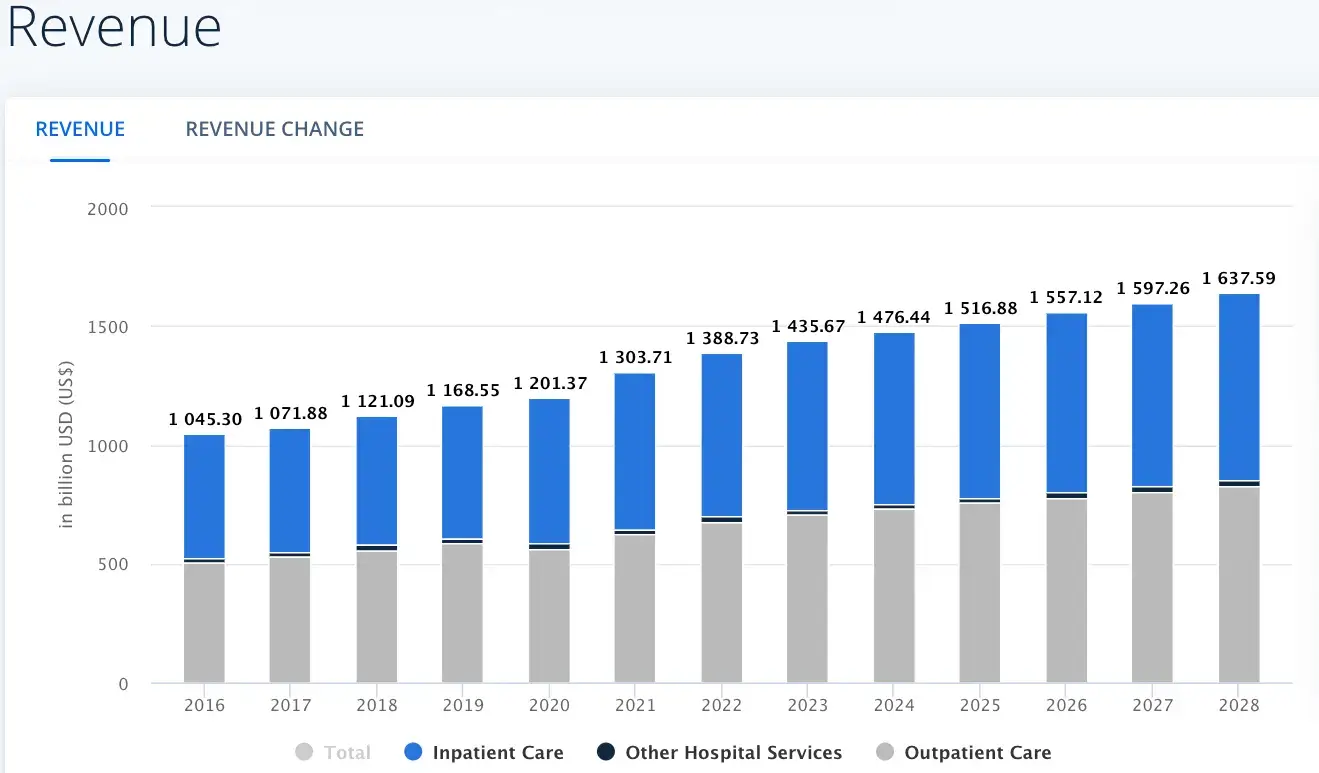Well-built marketing strategies are a requirement to grow a business and attracting new customers. That should go without saying. So, then, why do we seldom hear from the healthcare industry on the topic?
It’s no different than any other type of business is it? You still have the need to attract and retain new patients, right? Is there competition? You bet!
In fact, one could argue that it is one of the most competitive, and lucrative industries, with US revenues totaling more than $1 trillion dollars annually.

Source: Statista
This comprehensive healthcare marketing guide is designed to simplify the process of building your own marketing strategy from the ground up.
I’ll offer practical and relatable advice from 10+ years of working in healthcare marketing. Both in healthcare and health insurance.
We’ll discuss how to understand your patients better, use the latest technology to enhance your practice, and engage with your community through social media.
Shortcuts:
- Get to Know Your Patients Better
- Make the Most of Today’s Technology
- Connect with Your Local Community on Social Media
- Challenges & Safeguards in Healthcare Marketing
- Understanding If Your Efforts Are Paying Off

All images custom created in Canva
Whether you’re new to marketing or looking to refine your existing strategies, these insights will help make your efforts more successful.
1. Get to Know Your Patients Better
Understanding your patients isn't just about their medical history or symptoms—it's about recognizing their needs, preferences, and expectations from your practice.
Find out what they really want
The first step in truly understanding your patients is to discover what they value most in the care you provide them.
- Is it shorter waiting times?
- More personalized care?
- Timely follow-up procedures?
You might be surprised that small changes can significantly increase their satisfaction and loyalty to your practice.
One effective way to gather this information is through casual conversations during their visits. Paying attention to offhand comments or concerns can reveal a lot about patient preferences.
Also, keep an eye on trends in patient feedback can highlight areas for improvement or innovation in your services.
Use simple surveys to improve services
Patient surveys are a powerful tool for getting direct feedback from your patients. They don't have to be long or complicated.
Even a few questions sent via email or offered at the end of a visit can provide invaluable insights. Ask about their visit, the service they received, and any suggestions they have for improvement.
Make sure to include open-ended questions to capture detailed feedback.
The key is acting on patient feedback ASAP.
Whether adjusting your booking process or making your waiting room more comfortable, making these changes can significantly boost their trust and satisfaction with your practice.
Listen to patient stories to make your practice better
Patient stories are more than just testimonials; they're a window into the patient experience at your practice. Encourage your patients to share their journeys, challenges, and successes.
This can be done informally during appointments or through more structured means like a section on your website or social media platforms dedicated to patient stories.
Listening to these stories can help you identify patterns or recurring issues that may not be evident through surveys or data analysis alone.
They also remind you of the impact you can make on their lives, motivating you to further improve and adapt your services to meet their needs continually.
By prioritizing a deeper understanding of your patients, you enhance their experience and build a stronger, more patient-centered practice.
2. Make the Most of Today’s Technology
Leaning into technology can significantly increase the efficiency and reach of your practice, providing better care and convenience for your patients.
From offering services online to utilizing mobile apps and smart tools, technology opens up new avenues for connecting with and treating your patients.

Easy ways to offer services online
Offering services online is a game-changer for practitioners and patients, improving accessibility and convenience. Here are a few ways to get started:
- Telehealth appointments: Use platforms like Zoom, Doxy.me, or Teladoc to offer virtual consultations. These services comply with healthcare privacy laws and provide a secure way to meet with patients remotely.
- Online booking system: Implement an online appointment scheduling tool like Zocdoc or SimplyBook.me, allowing patients to book, cancel, or reschedule their appointments without the need to call your office.
- Patient portals: Integrate patient portal software with your Electronic Health Records (EHR) system. This lets patients access their medical records, lab results, and prescription refill requests from home. Popular EHR systems with robust patient portals include Epic MyChart and Cerner Health.
Keep in touch with patients easily
Mobile apps can streamline patient communication and offer them resources at their fingertips.
Consider these examples:
- Personal Health Record (PHR) Apps: Encourage using a top-rated PHR app like Medisafe or even free apps like MTBF PHR or MedFusionPlus. Patients can keep track of their health information and communicate with your office.
- Medication reminder apps: Recommend apps like Medisafe to patients who need help managing their medication schedules, ensuring better adherence to treatment plans.
- Custom made app: Develop a custom app with features like appointment scheduling, health tips, and direct messaging. For example, Appy Pie can help you create an app without needing coding skills.
Use smart tools to send the right messages
Communicating effectively with your patients ensures they receive the right information at the right time. Here are some smart tools and examples of how to use them:
- Email marketing software: Tools like Mailchimp or Constant Contact can be used to send newsletters, health tips, and practice updates to keep your patients informed and engaged.
- SMS appointment reminders: Use SMS services like Twilio or SimplyCast to send appointment reminders, reducing no-shows and ensuring patients are prepared for their visits.
- Social media: Platforms like Facebook and Instagram can be used to share health tips, news about your practice, and public health information. This not only educates your patients but also helps in building a community around your practice.
Start with one or two of these solutions that seem most beneficial to your practice and patient base, and then expand as you become more comfortable with the technology.
3. Connect with Your Local Community on Social Media
Social media offers a powerful platform for medical practices to connect with their community, engage patients, and build a stronger online presence.
It's about more than just posting; it's about creating a space where your values and expertise can shine.

Find the best social media spaces for your practice
Choosing the right platforms is crucial for effective engagement. Consider these tips:
- Understand your audience: Different platforms attract different demographics. Facebook is great for reaching a broad, older demographic, while Instagram and TikTok appeal to younger audiences. LinkedIn can be ideal for professional networking and sharing more in-depth health articles.
- Quality over quantity: It's better to be highly active and engaging on one or two platforms than to spread yourself too thin. Pick platforms where your patients are most active and focus your efforts there.
- Engage with Local Communities: Many social media platforms have community groups. Joining health-focused Facebook groups can help you reach potential patients within your area.
Simple ideas to keep patients engaged online
Keeping your audience engaged requires creativity and consistency. Here are some ideas:
- Weekly health tips: Share simple, actionable health tips that your followers can easily incorporate into their lives. Use hashtags to increase visibility.
- Q&A sessions: Host live Q&A sessions where you answer common health questions. This not only provides value but also increases engagement.
- Behind-the-scenes content: Share behind-the-scenes glimpses of your practice, introducing your team and showing the care you put into your work. It humanizes your practice and builds trust.
Keep your practice's reputation sparkling online
Maintaining a positive online reputation is essential. Here's how to manage it:
- Monitor your online presence: Regularly check reviews and mentions of your practice on social media and review sites like Healthgrades or Google Reviews. Tools like Google Alerts can help you stay informed.
- Respond to feedback: Acknowledge both positive and negative feedback promptly and professionally. For negative reviews, offer to resolve the issue offline. This shows that you care about patient satisfaction.
- Encourage positive reviews: After a positive experience, gently encourage satisfied patients to share their feedback online. This can help offset any negative reviews and improve your overall online presence.
By actively engaging with your community on social media, you enhance your practice's visibility and establish a trustworthy and approachable image.
Remember, the goal is to create meaningful connections with your patients, providing them with valuable information and showing the human side of your practice.
4. Challenges and Safeguards in Healthcare Marketing
You want to connect with more patients and share what makes your practice special, but there are legal, ethical, and practical hurdles to consider.

Keep it legal and honest
Marketing your healthcare services isn't just about creativity; it's about staying within the lines of the law and ethical standards.
It's crucial to know the basics of healthcare laws like HIPAA, which protects patient information, and to always present your services truthfully.
Simple rule of thumb: if you wouldn't say it directly to a patient in your office, don't say it in your marketing. Setting up a basic review process for all your marketing materials can help keep things on track.
Guard patient privacy online
As you explore digital marketing, remember that patient privacy is your top priority.
Whether you're emailing patients, sharing success stories on your website, or posting on social media, always ensure you have consent and that patient information is protected.
A good practice is to regularly check your digital tools and platforms to make sure they're secure and compliant with privacy regulations.
Overcoming patient doubts
Your patients are more informed and cautious about the health information they consume online, so to build trust, focus on transparency and back up your claims with evidence.
Sharing patient success stories (with their permission) or explaining treatment options in simple, understandable language can go a long way.
Also, being active and responsive on social media can help show patients the real people behind your practice.
Make digital marketing work for you
Keeping up with digital marketing trends doesn't mean you have to be a tech wizard.
Focus on a few key areas like making sure your website is easy to find and read (SEO basics), using social media to share helpful health tips, and managing your online reputation by responding to reviews.
There are plenty of cost-effective tools and resources out there designed for beginners.
It's about striking the right balance between reaching out to new patients and staying true to the core values of healthcare.
5. Understanding If Your Efforts Are Paying Off
Determining the success of your marketing efforts is crucial to ensure that your strategies are effective and to make informed decisions for future campaigns.
It's about understanding the impact of your actions on patient engagement, satisfaction, and, ultimately, on your practice's growth.

How to tell if your patients love your marketing efforts
The most direct way to understand if your marketing resonates with your patients is through their feedback and engagement levels.
Increased appointment bookings, more inquiries through your website or social media platforms, and positive comments or messages indicate that your content is hitting the mark.
Patient surveys can be a goldmine of information, providing direct insights into what your patients think about your marketing content and what they’d like to see more of.
When patients begin to mention specific campaigns, tips, or stories you've shared in their interactions with you, it's a clear sign that your marketing efforts are not just being noticed but appreciated.
What web visits and likes really mean for your practice
Web visits, likes, and other social media engagements are often seen as vanity metrics, but they can offer valuable insights into the effectiveness of your marketing strategies.
Increased web traffic suggests that more people are interested in your practice, which can be attributed to your marketing efforts driving awareness.
Likes, shares, and comments on social media posts indicate that your content is engaging and resonates with your audience.
However, the true measure of success goes beyond these numbers; it's about converting that interest and engagement into tangible outcomes like appointments or referrals.
Figuring out the value of your marketing: A 5-step simple guide
To assess the value of your marketing efforts effectively, consider the following points in bullet format:
1. Compare costs vs. benefits
Evaluate the expenses involved in your marketing activities. Measure the increase in patient numbers and the uptick in services they utilize as a direct result of your marketing.
2. Assess immediate returns
Immediate revenue increases from new or returning patients directly linked to specific marketing campaigns.
3. Evaluate long-term impact
Check if there is an increase in the frequency of patient visits and broader utilization of offered services, indicating a deeper trust and reliance on your practice.
4. Consider patient behavior
Monitor patient testimonials and referrals as indirect markers of the effectiveness of your marketing strategies. Patients referring others are strong indicators of a successful marketing approach.
5. Track overall satisfaction
Use patient feedback to gauge overall satisfaction and trust in your practice, which can be boosted by effective marketing.

Evaluating the success of your marketing strategies is an ongoing process that requires attention to both quantitative metrics and qualitative feedback.
By staying tuned into your patients' responses and keeping an eye on the broader impacts of your efforts, you can ensure that your marketing reaches those who need it.
Conclusion
Ultimately, it's all about finding the right way to connect with your patients while keeping their trust and privacy at the heart of what you do.
By getting to know what your patients need, using the latest tech to make their lives easier, and sharing stories and tips that matter to them, you can grow your practice in a way that feels genuine and caring.
Remember, at the end of the day, it's not just about attracting more patients; it's about building a community where everyone feels valued.
About the author:
Hey, it's Mick and I'm the Head of Growth and Partnerships at POWR. My career spans two decades, primarily marketing in the healthcare space, with stints in broadcast television, advertising and copy editing.
I went to the College of Journalism at the University of Louisiana - Monroe and a storyteller at my core. My wife Elizabeth, son Gavin, and pup Jolene currently call Lafayette, Louisiana home.
Follow me on LinkedIn.




